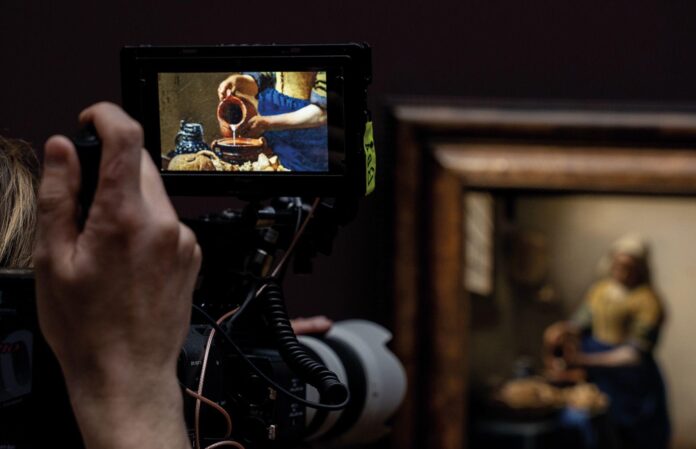“We certainly didn’t predict this,” says the award-winning film-maker Phil Grabsky. “Clearly, we have provided something that people are very excited about. The stars have all aligned.”
Grabsky—who, a decade ago, established Exhibition on Screen, a series of documentaries about art and artists based around exhibitions—is talking about his recent film Vermeer: The Greatest Exhibition, which has broken the company’s box-office record since its cinema release in the UK on 18 April. At the time of writing, the film’s takings are reported at just over £818,000, from screenings in around 300 cinemas, an excellent result for a film that is essentially a supercharged guided tour of an art gallery.
It helps, of course, that the art gallery in question is the Rijksmuseum in Amsterdam, and that the subject of the film—the universally acclaimed assembly of 28 of the 37 known works by the 17th-century Dutch Old Master painter—sold out almost immediately. Like the touring “event films” released by London’s National Theatre or New York’s Metropolitan Opera, this allows those unable to attend a major cultural event—the vast majority of the potential audience—the ability to experience it. Grabsky is aware that there will always be suggestions that films somehow devalue the art. “We do not say, ‘you do not need to go to the shows anymore.’ The idea is to do both.”
The Exhibition on Screen films offer added value, with curators, researchers and critics talking on camera and interpolating contextual detail including artists’ biographical information, readings from letters and the like. Grabsky—who has shared the majority of directing duties with artist and film-maker David Bickerstaff—has overseen a simple, elegant style, strong on clarity and watchability involving lingering close-ups of the work and intelligent, but not opaque, critique of the work.
The series now runs to 34 films, with titles ranging from the blockbuster (Leonardo: The Works and I, Claude Monet) to the less obvious (The Danish Collector: Delacroix to Gauguin, about pioneering Impressionist collector Wilhelm Hansen). With a “season” of four to five offerings per year, not all the films do as well as Vermeer, and Grabsky is upfront about the business side of it. “I have worked at the cutting edge of film-making for 40 years, and getting any film about art made is really tough. There are some films that we take risks on, there are some that felt like they were going to do slightly better than they did. The great thing about Vermeer is that it allows us to take more risks with future productions.”

Filming Tokyo Stories, about 400 years of artists based in the city Photo: David Bickerstaff; © Exhibition On Screen
Grabsky says the series is “largely self-funded”, with each film costing around £250,000 to make. In the UK, broadcast TV has largely given up on shows about art, he says. But he is hopeful that, now the film catalogue is pretty sizeable, he can make a deal with a streaming company. “My hope is someone like Netflix will come along and say, ‘we want to talk to an older, more cultured audience’.”
A handsome record
In terms of the actual subjects, Grabsky is keen to point out that he does not operate as a marketing arm for galleries—they do not pay to be included, nor do they get final cut—but, he says, they are enthusiastic to participate as, on top of everything else, they get a handsome record of their exhibition. He also points out that many of their films are not walk-throughs of a specific exhibition. The recent release Tokyo Stories is a case in point: “It is sparked by the Ashmolean’s Tokyo show [Tokyo: Art & Photography, 2021] but it is also an opportunity to make a film about 400 years of Tokyo-based artists looking at their city.”
Grabsky says he is currently working on a film about Klimt’s painting The Kiss (1907-08). “It won’t do as well, but we want it in the catalogue as we have never done anything about the whole Secession period,” he says. “I always come back to this: it is all about storytelling. We are driven by our own interests, by what we think the audience is interested in—and what we can make them interested in.”

























